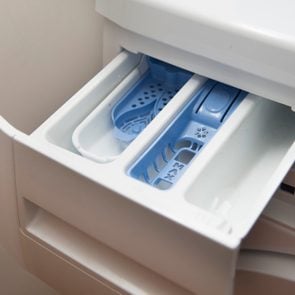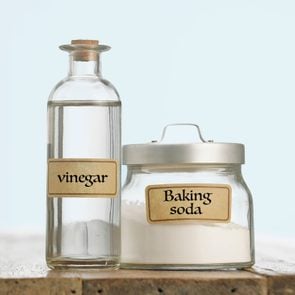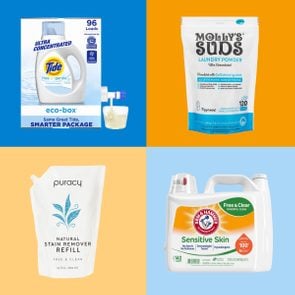How to Tell If You’re Using Too Much Laundry Detergent
Updated: Apr. 19, 2024
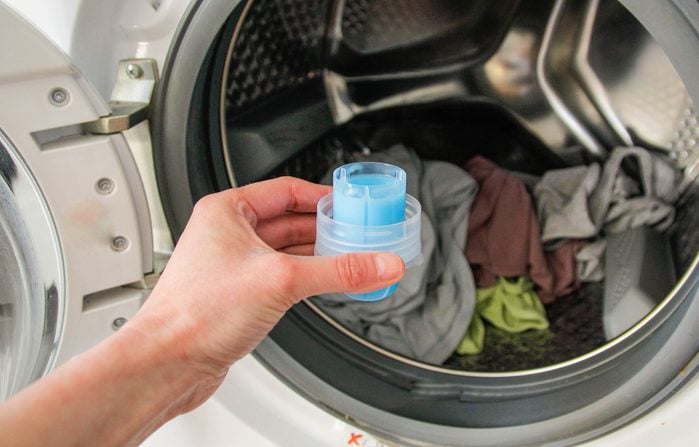
Even when laundry is filthy, smelly and stained, more detergent isn't necessarily better. Here's how much laundry detergent to use.
Our society lives by the mantra “more is more.” More clothes, more desserts, more vacations—you name it. So naturally when determining how much laundry detergent to use, we assume more detergent is better to get our clothes fresh and clean. And when stains or sweat are involved? Go big or go home, right?
Well, not quite. While it seems logical that more suds would mean squeaky-clean garb, the opposite is actually true. To get the inside scoop, Reader’s Digest spoke to stain expert Mary Gagliardi, aka Dr. Laundry, a laundry scientist at Clorox, and Laura Johnson, a research and development analyst with LG Electronics, which makes washers and dryers.
“With all detergent, avoid using too much,” says Johnson. “This can create too many suds, leading to higher water use, and can lead to buildup in the washer over time, which can cause odor issues.”
Learning how to do laundry the expert-approved way is a surefire method to ensure your clothes look pristine and smell fresh. Whether you’re on the fence about powder vs. liquid detergents or need a refresher on how to use laundry pods, these expert-approved tips will help you determine how much detergent to use and, if you’re going overboard on the suds, how to scale back.
Get Reader’s Digest’s Read Up newsletter for more cleaning, tech, travel, humor and fun facts all week long.
About the experts
Reviewed for accuracy by: Mary Marlowe Leverette, a highly regarded fabric-care, stain-removal and laundry expert with more than 40 years of experience. |
How much laundry detergent to use
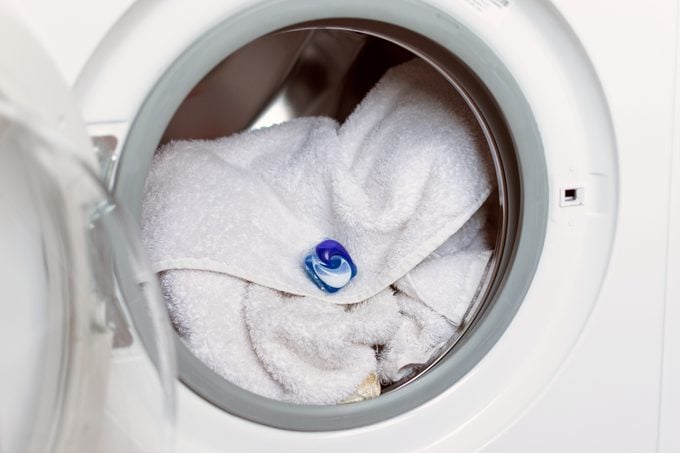
Like other companies, detergent manufacturers want to increase their sales. A common strategy is to recommend using more detergent than necessary.
We know that high-efficiency, or HE, washers cut down on water, energy and detergent. As HE washer-and-dryer sets grow in popularity, people are using less detergent than ever before. To boot, the machines themselves keep getting larger, with the capacity to wash huge amounts of clothing in one load. That means families are running fewer cycles. This is all great news for American households but not so great for detergent sales.
So are companies upping the recommended doses unnecessarily? Maybe. You can be the judge. But to save your money and your sanity, we’ve outlined exactly how much detergent to use for standard and HE washers.
-
Premeasured packs: Pop in one per cycle for each type of machine.
-
Powder detergent: Standard washers take a quarter cup. If you’re dealing with some serious dirt, use a half cup. HE washers work best with two tablespoons.
-
Liquid detergent: Use two tablespoons for a standard washer and two teaspoons for an HE washer.
-
If your water is soft: Level down to one-and-a-half tablespoons for a standard machine, and one-and-a-half teaspoons for an HE model.
How much detergent to use in high-efficiency washers
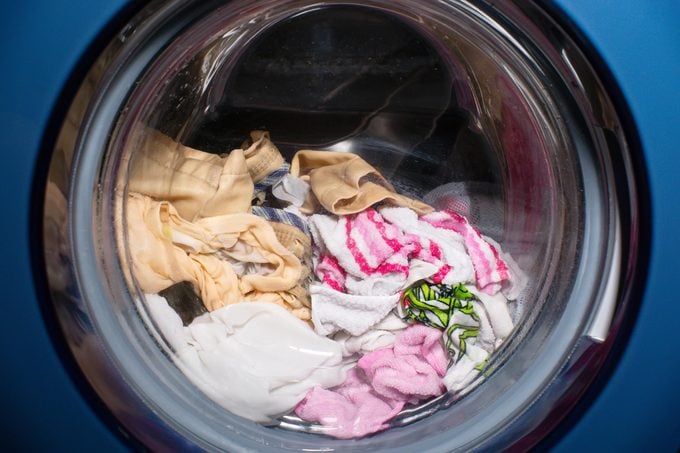
“If you have a high-efficiency clothes washer, you must use an HE detergent,” says Mary Gagliardi, aka Dr. Laundry. She says they are specifically formulated for machines that use less water per wash and will clean clothes without excessive suds.
“HE washers provide much more gentle agitation and therefore are much more gentle on fabrics,” she says. “However, this also means they do not clean as aggressively, and they rely more heavily on laundry product chemistry to make up the difference.”
This isn’t a green light to use cups and cups of detergent—quite the opposite. These machines use smaller amounts of water, and as such, they perform better with less detergent, so the ratio of soap to water is balanced. Think about it: If there’s a small amount of water but huge amounts of detergent, the soapy solution overpowers the water, which will have a tougher time thoroughly rinsing off all the excess soap. Your just-laundered clothes will end up with a sticky residue.
“The biggest difference with HE detergents is the different cleaning agents used,” says Gagliardi. “They don’t cause foam, which is a complete change from regular detergents, which do produce foam that is visible on top of the wash water during the cycle.”
She adds that HE washers have more variable cleaning because of the way the clothing bounces through the wash cycle. “For most laundry, this isn’t a problem, but for colored items with stains, pretreating the stain before washing is very important,” she says.
You can use HE detergent in traditional washing machines too, “just don’t expect any foam or suds,” Gagliardi warns. “Of course, a standard detergent is your best choice for a standard deep-fill washer,” she says.
How much detergent to use in top-load washers
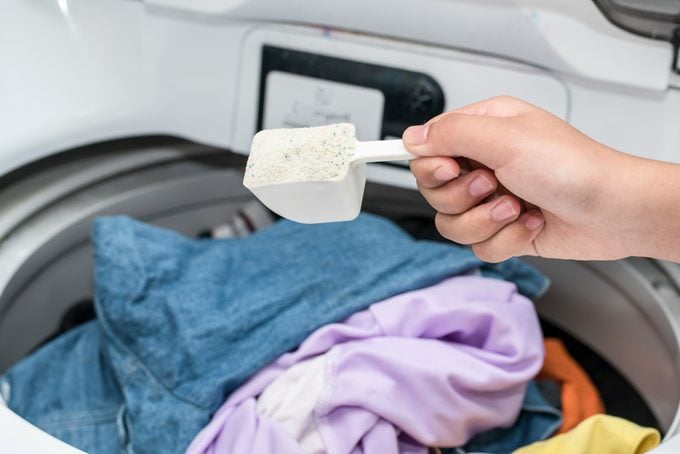
A traditional top-loading washer has a central agitator that swishes around detergent, clothes and a lot of water to lift stains and get stubborn smells out of clothes. “Traditional washers more aggressively agitate the laundry, translating to more uniform cleaning because they are completely submerged in the wash solution,” says Gagliardi.
Since top loaders use a lot more water than HE machines—a whopping 40-plus gallons to HE washers’ three to five—accidentally using a tad more detergent won’t be too harmful because the water-to-laundry load ratio is so high.
The biggest annoyance with using too much detergent in a top loader is washing the product (and by extension, your money) down the drain. So do your wallet a favor and follow the instructions on the detergent packaging, but use the lowest level recommended, even for larger loads.
And don’t just eyeball the amounts when deciding how much laundry detergent to use, says Gagliardi. Actually measure out the product to make sure you’re using the lowest level of detergent needed. “Please do measure,” she says. “Pouring detergent directly from the bottle into the water without measuring is a great way to make sure you use the wrong amount—either too much or too little!”
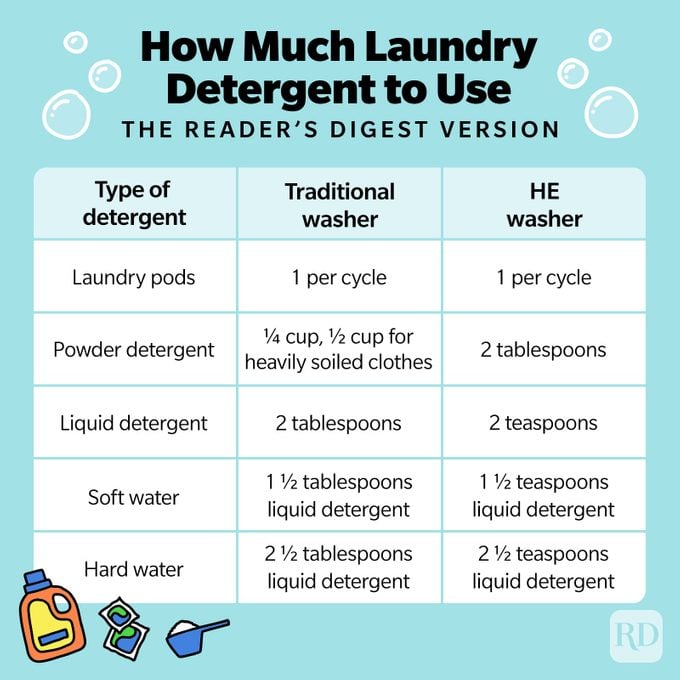
Signs you’re using too much laundry detergent
If you think you may be getting a little detergent-happy with your laundry, take a look at a just-washed load. If your wet clothes feel a little slimy, sticky or soapy, you’re probably sensing detergent residue. It’s a telltale sign you’re using too much product. Using too much detergent can also make your clothes smell funky, because the film it creates on clothes can actually trap in odors and bacteria.
Other red flags include wet clothes that feel stiff or slightly hardened, colored clothes that have lost their vibrancy, and white clothes that have turned off-white or gray. If you’re dealing with any of that, it’s likely due to your laundry detergent.
And finally, the king of all red flags: If your high-efficiency washing machine smells bad, moldy or musty, it’s probably because soap has built up over time. And if this happens, you’ll need to clean your washing machine with baking soda or vinegar before you do anything else.
Signs you’re not using enough laundry detergent
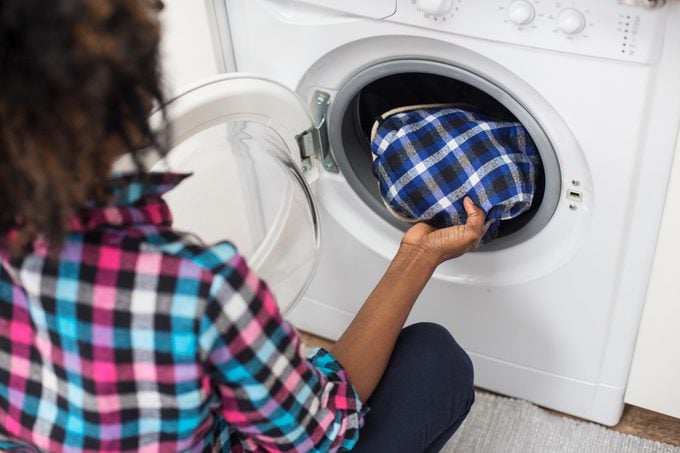
Less is more, generally speaking. But there are rare times when soiled clothes call for more detergent.
If your clothes are super dirty (think: your child’s soccer uniform after a game), then using an extra dash of detergent will help remove dirt. Just be sure you’re referring to the garment’s laundry symbols to make sure you’re cleaning it properly. And don’t pour detergent directly on soiled clothes to sit overnight before washing; this can leave detergent marks on the fabric.
Instead, Mary Marlowe Leverette, a fabric-care expert and consultant with more than 40 years of experience, suggests creating a presoak solution of two tablespoons of liquid detergent per gallon of warm water. Submerge the heavily soiled item, and allow it to soak for at least two hours or overnight as a more effective stain-removal method.
Detergent usage guidelines on the packaging are based on the drum size of a traditional washing machine. If your model is supersized with a larger drum (typically seen in newer machines), you’ll need to use a bit more than the detergent instructions say because larger loads equal more clothes and more grime to rinse away. So if you use a single laundry pod for your usual load, you might toss in two for extra-large loads. A large load of laundry is typically considered to be a load that fills the washer at least three quarters of the way full, but it can vary by machine.
Another little-known fact is that water hardness affects the efficacy of laundry detergent. If you live in an area with hard water—and it varies throughout the country—then you’ll need to use more detergent.
Why trust us
At Reader’s Digest, we’re committed to producing high-quality content by writers with expertise and experience in their field in consultation with relevant, qualified experts. For this piece, Kaitlin Clark tapped her experience covering laundry advice and clothing care, and then Mary Marlowe Leverette, a fabric-care, stain-removal and laundry expert with more than 40 years of industry experience, gave it a rigorous review to ensure that all information is accurate and offers the best possible advice to readers. We verify all facts and data, back them with credible sourcing and revisit them over time to ensure they remain accurate and up to date. Read more about our team, our contributors and our editorial policies.
Additional reporting by Alexa Erickson.
Sources:
- Laura Johnson, a research and development analyst with LG Electronics; interviewed September 2021
- Mary Gagliardi, aka Dr. Laundry, a stain scientist at The Clorox Company; interviewed September 2021
- Mary Marlowe Leverette, a fabric-care, stain-removal and laundry expert with more than 40 years of industry experience; interviewed January 2024

